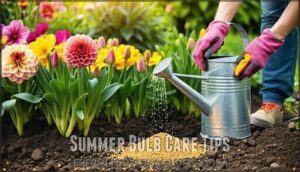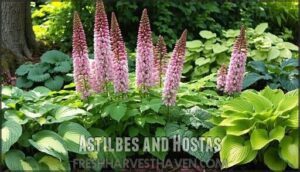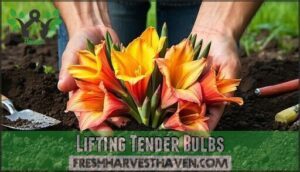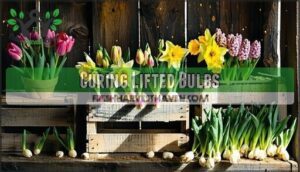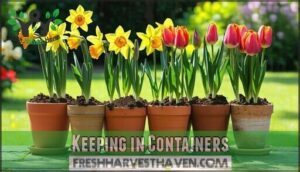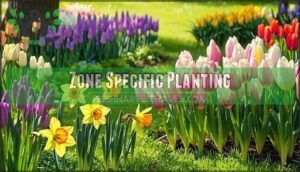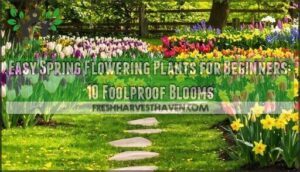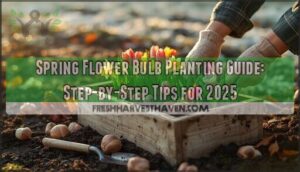This site is supported by our readers. We may earn a commission, at no cost to you, if you purchase through links.
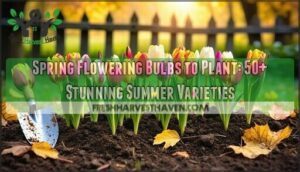 You’ll want to plant spring flowering bulbs to plant in fall for gorgeous spring blooms.
You’ll want to plant spring flowering bulbs to plant in fall for gorgeous spring blooms.
Choose hardy varieties like tulips, daffodils, crocuses, and hyacinths that’ll naturalize in your garden.
Plant them 6-8 weeks before hard frost when soil temperatures drop below 60°F.
Most bulbs need well-draining soil and full to partial sun.
Plant pointed end up, typically 2-3 times the bulb’s height deep.
These beauties reward your patience with vibrant colors that’ll chase away winter’s gloom.
The secret lies in timing, placement, and understanding what each variety needs to thrive in your specific growing zone.
Table Of Contents
- Key Takeaways
- Planting Spring Bulbs
- Summer Bulb Care Tips
- Arranging Summer Blooms
- Popular Spring Bulbs
- Winter Care Techniques
- Zone Specific Planting
- Frequently Asked Questions (FAQs)
- What’s the best time to plant spring bulbs?
- What perennial bulbs bloom all summer?
- What is the order of bloom of spring bulbs?
- Can I plant spring bulbs anytime?
- How deep to plant summer bulbs exactly?
- Can bulbs be planted in shady areas?
- What prevents bulbs from blooming at all?
- How to divide and replant old bulbs?
- Are all summer bulbs deer resistant naturally?
- How deep should I plant different bulb sizes?
- Conclusion
Key Takeaways
- Plant in fall for spring blooms – You’ll need to plant spring-flowering bulbs 6-8 weeks before your first hard frost, when soil temperatures drop below 60°F, giving them the winter chill period they need to bloom properly.
- Choose zone-appropriate varieties – You’ll have better success selecting bulbs that match your hardiness zone, from hardy crocuses and daffodils in zones 3-4 to heat-tolerant varieties like freesias in warmer zones 8-10.
- Focus on proper soil and placement – You’ll want well-draining soil with a pH between 6.0-7.0, planting bulbs pointed-end up at a depth that’s 2-3 times their height, in locations with full to partial sun exposure.
- Plan for easy maintenance – You’ll enjoy years of blooms with minimal effort, since hardy varieties like daffodils and crocuses naturalize in your garden, while tender summer bulbs, like dahlias and gladiolas, need lifting and storage in cold climates.
Planting Spring Bulbs
Planting spring bulbs in fall sets the stage for spectacular blooms that’ll transform your garden come spring.
You’ll want to get them in the ground about 6-8 weeks before your first hard frost, when soil temperatures consistently stay below 60°F.
Choosing Right Time
When fall arrives, timing your bulb planting becomes critical for optimal season success.
Plant when soil temperature consistently stays below 60°F but above freezing—typically 6-8 weeks before first frost. Check your hardiness zone range and use a soil thermometer for accuracy.
Knowing the ideal soil temperature is key for successful bulb planting.
Fall planting timing affects bloom timing, with bulb type determining specific needs. Proper planting time guarantees strong root development before winter dormancy.
Selecting Suitable Zone
Your hardiness zones determine which bulbs will thrive in your garden’s unique conditions.
Your yard might differ from surrounding areas because microclimates matter too.
Consider these key factors:
- Frost dates guide timing for tender varieties
- Regional variations affect bloom success rates
- Local nurseries stock zone-appropriate bulb zones
Understanding your planting zones and growing zones guarantees your planting season efforts pay off with stunning blooms.
Preparing Soil Conditions
Once you’ve chosen your zone, proper soil preparation becomes your foundation for blooming success.
Your bulbs thrive in well-draining soil with ideal pH levels between 6.0-7.0 and rich organic matter content.
Well-draining soil with the right pH creates the perfect foundation for thriving spring bulb displays.
Follow these soil preparation steps:
- Loosen soil to 8-12 inches deep using double digging techniques
- Test pH levels and adjust with lime or sulfur as needed
- Add organic matter like compost to improve soil drainage and nutrient balance
- Remove debris including rocks and old plant material
- Mix soil amendments such as bone meal for phosphorus-rich fertilizing bulbs
Quality soil conditions with proper planting depth create the perfect environment where your spring bulbs can establish strong root systems and deliver spectacular blooms.
To accurately measure acidity, consider using a reliable soil tester.
Avoiding Heavy Rain
Timing your planting bulbs around weather patterns prevents disaster. Heavy rain creates waterlogged conditions that rot bulbs before they establish.
Check forecasts and delay planting during wet periods. Improve drainage solutions with raised beds or soil amendments like compost.
Choose shelter options under trees or structures. Proper soil preparation guarantees welldraining soil, while correct bulb depth and careful watering bulbs protect your investment from soggy conditions.
Consider the soil’s pH level for superior bloom color.
Summer Bulb Care Tips
Once your spring-planted bulbs are actively growing, they’ll need consistent care to produce those stunning summer blooms you’re expecting.
You’ll want to establish a regular watering schedule, provide monthly fertilization, watch for common pests, and give taller varieties the support they need to thrive.
This includes activities like monthly fertilization, which is crucial for healthy growth and flowering.
Watering Regularly
Watering your spring flowering bulbs correctly means achieving consistent moisture without drowning them.
Check soil drainage by inserting your finger two inches deep—if it’s dry, it’s time to water.
Adjust watering frequency based on rainfall and temperature. Deep, weekly watering beats frequent shallow sprinkles for proper bulb hydration.
Well-draining soil prevents root rot while maintaining the moisture your bulbs crave for healthy spring garden care.
Fertilizing Monthly
Monthly feeding keeps your spring flowering bulbs thriving throughout their growing season.
Proper bulb fertilizer application guarantees vibrant blooms and healthy plant development.
Consider these nutrient needs:
- Test soil pH levels before selecting fertilizer types for maximum absorption
- Apply balanced 10-10-10 fertilizer using granular application methods around plant bases
- Monitor for over-fertilizing risks like excessive foliage growth at bloom expense
Regular soil testing guides your bulb care routine effectively, ensuring healthy plant development and helping you avoid over-fertilizing risks to achieve proper bulb fertilizer application.
Monitoring Pests
Keep your bulbs healthy by identifying pests early through weekly inspections.
Look for aphids’ sticky honeydew, slug slime trails, and wilting from bulb fly larvae.
Encourage natural predators like ladybugs and predatory mites.
Apply organic controls including neem oil and diatomaceous earth.
Use chemical treatments sparingly during dormancy.
Preventing infestations starts with proper bulb care and avoiding overwatering around deer resistant varieties.
Providing Support
Three staking techniques will keep your tall summer bulbs standing proud.
Use bamboo stakes for gladiola reaching five feet, while cage options work perfectly for dahlias with dinner-plate blooms.
Trellis systems support climbing varieties, and strategic wind protection prevents stem breakage.
Position supports early when plant height reaches six inches, ensuring full sun lovers get proper soil amendments for strong growth.
Arranging Summer Blooms
You’ll create stunning displays by strategically placing tall summer bloomers like gladiola and canna lilies as dramatic backdrops, while shorter varieties like dahlias and freesias fill the foreground.
Mix complementary colors and textures in large planters to showcase each variety’s unique characteristics and extend your garden’s visual impact throughout the growing season, utilizing summer bloomers to enhance the display.
Placing Tall Flowers
Your garden’s backbone begins with strategic placement of tall flowers like gladiolus and dahlias.
Create stunning Garden Backdrops by positioning these Vertical Accents at borders’ rear, considering bulb height for Staggered Heights.
Establish Focal Points through thoughtful garden design with bulbs, ensuring Wind Protection for towering stems.
This spring garden design ideas approach transforms planting locations into enchanting displays with perfect visual flow.
Using Large Planters
Selecting the right planter size creates freedom to showcase your spring bulbs beautifully.
Large containers offer superior drainage needs and soil choice flexibility for container gardening success.
Bulb density matters—space tulips, daffodils, and hyacinths appropriately for maximum growth.
Consider aesthetic design when positioning flowering bulbs, ensuring your bulb planting creates stunning displays.
Proper container selection addresses essential drainage concerns.
Follow these planting tips for vibrant blooms that’ll make neighbors envious.
Mixing Bloom Varieties
Once you’ve positioned larger planters strategically, mixing bloom varieties creates layers of visual interest throughout your spring garden design.
Smart bulb combinations enhance both Color Harmony and Seasonal Interest by coordinating Bloom Time sequences.
Consider these spring flowering bulbs partnerships:
- Early bloomers with late varieties: Combine crocuses (March) with tulips (May) for extended spring blooms
- Height Variation mixing: Plant short grape hyacinths beneath tall daffodils for natural layering
- Texture Contrast blending: Pair feathery allium globes with cup-shaped tulips for dynamic spring garden design
Pairing Bold Colors
Bold color combinations create dramatic visual impact when you pair spring flowering bulbs strategically.
The Color Wheel guides your choices—complementary colors like purple tulips with yellow daffodils create vibrant contrasts, while analogous palettes offer harmonious blends.
- Complementary Colors: Pair orange tulips with blue grape hyacinths for striking spring garden color
- Monochromatic Schemes: Layer different purple bulb combinations from light lavender crocuses to deep violet hyacinths
- Contrasting Textures: Mix smooth tulip petals with spiky allium blooms for dynamic flower colors
Popular Spring Bulbs
You’ll discover that spring bulbs like tulips, daffodils, and hyacinths create stunning displays when planted strategically throughout your garden.
These hardy performers reward your fall planting efforts with reliable blooms that signal winter’s end and brighten your landscape for weeks, showcasing their beauty as stunning displays.
Dahlias and Gladiolus
Dahlias shine with their massive bloom size variations—from 2-inch pompoms to dinner plate-sized showstoppers.
These summer flowering bulbs deliver incredible color variety in reds, purples, and yellows.
Gladiola corms produce towering spikes that need staking to prevent toppling.
Both require monthly pest control checks and work beautifully in arrangement ideas, creating stunning focal points in your garden sanctuary.
Lilies and Delphiniums
Beyond dahlias, lily varieties and delphiniums create stunning vertical drama in your spring flowering bulbs garden.
Asiatic and Oriental lilies thrive in zones 4-9 with 90% survival rates, while delphiniums reach 6-8 feet requiring sturdy support.
Remember lily toxicity affects cats severely—choose companion plants wisely for safe garden design.
- Hybrid varieties offer extended bloom pairing opportunities throughout summer seasons
- Delphinium poisoning requires careful placement away from children and pets
- Planting guide recommends dividing lily clumps every 3-4 years for continued vigor
Astilbes and Hostas
Astilbes and hostas create your ultimate shade gardening duo, transforming dark corners into vibrant spring gardens.
These companion plants offer stunning foliage contrast—astilbes deliver feathery plumes while hostas provide bold leaves.
| Feature | Astilbe varieties | Hosta care |
|---|---|---|
| Bloom Colors | Pink, white, red, lavender | Fragrant white/purple spikes |
| Leaf Appeal | Fern-like texture | Heart-shaped giants |
| Garden Impact | Pollinator magnet | Slug-resistant options |
Astilbes excel in partial shade with high organic content soil and constant moisture.
Meanwhile, hostas boast over 4,000 cultivars, making them collectors’ favorites among spring flowering bulbs for shaded areas.
Hellebores and Pulmonaria
Why wait for spring when you can create a woodland sanctuary now? Hellebores bloom in late winter, while pulmonaria adds spotted foliage and early spring flowers to shaded areas.
- Hellebore varieties bloom January through March, surviving -20°F temperatures
- Pulmonaria cultivars offer blue, pink, and white flowers with distinctive spotted leaves
- Companion plants like astilbes and hostas create layered woodland design
- Shade gardening thrives with these deer-resistant, low-maintenance perennials
- Spring garden flowers provide early nectar for emerging pollinators
Winter Care Techniques
When cold weather arrives, you’ll need to protect tender bulbs that can’t survive freezing temperatures.
Most spring-planted summer bloomers like gladiolas, dahlias, and begonias require lifting and proper storage to guarantee they return next season.
Lifting Tender Bulbs
When frost threatens, you’ll need to lift tender perennials like gladiolus and dahlias through fall digging. Proper timing matters—wait until foliage yellows but before hard freeze.
Carefully dig corms and bulbs, then inspect for disease signs during bulb inspection. This disease prevention step guarantees healthy specimens for replanting season.
Clean tools prevent contamination during winter storage preparation. Applying mulch can help with insulating soil during storage.
Storing in Cool Areas
Most bulbs thrive in ideal temperature ranges of 35-50°F with moderate humidity levels around 60-70%.
Proper ventilation needs include air circulation to prevent mold during bulb dormancy. Store your treasures in mesh bags or crates for bulb storage, checking monthly for pest prevention.
This winter storage approach guarantees your buying bulbs investment pays off. Unlike your fall planting guide, growing bulbs indoors requires consistent monitoring for success.
Curing Lifted Bulbs
Once you’ve stored bulbs properly, you’ll need to cure them before winter dormancy. Start by cleaning dirt from lifted bulbs and trimming damaged roots. Place bulbs on screens or newspaper in a well-ventilated area for 2-3 weeks.
Guaranteeing successful curing involves selecting the right bulb curing supplies.
Essential curing steps for healthy bulbs:
- Ideal Temperature: Maintain 40-50°F for perfect drying without freezing damage
- Ventilation Needs: Guarantee good airflow prevents moisture buildup and mold growth
- Rot Prevention: Remove soft, damaged bulbs immediately to protect healthy ones
- Storage Mediums: Use mesh bags, wooden crates, or newspaper for proper air circulation
- Dormancy Period: Allow full curing time before long-term winter storage
Proper bulb maintenance during curing sets the foundation for successful spring garden maintenance and healthy bulb propagation next season.
Keeping in Containers
Container care begins with choosing pots that offer proper drainage needs for your tulip bulbs, daffodil bulbs, and hyacinth bulbs.
Select container soil that’s well-draining and position containers where they’ll receive adequate sunlight exposure.
For overwintering bulbs, maintain proper bulb spacing and protect spring bulbs from freezing temperatures. These flower bulbs need consistent moisture but never waterlogged conditions throughout their dormant period.
Zone Specific Planting
Your success with spring-flowering bulbs depends on choosing varieties that match your specific hardiness zone and understanding their unique temperature requirements.
Each zone presents different challenges and opportunities, from the harsh winters of Zone 3 that limit your options to hardy varieties like crocuses and daffodils.
To the warmer climates of Zones 8-10 where you can grow tender beauties like freesias and gladioli year-round.
Zone 3-4 Planting
Winter’s grip demands tough choices for gardeners in zones 3-4.
Plant your tulip bulbs, daffodil bulbs, and crocus bulbs in late September when nighttime temperatures drop consistently.
These hardy spring bulbs handle cold hardiness challenges better than tender varieties.
Apply mulch protection using 2-4 inches of straw to prevent frost heaving during freeze-thaw cycles.
Short seasons require strategic bulb selection – choose proven performers like hyacinth bulbs that withstand -40°F temperatures.
Zone 5-6 Planting
You’ll plant spring bulbs in zones 5-6 during October to early November when nighttime soil temperatures drop below 60°F.
Soil amendments like compost or bone meal boost root establishment, while mulching benefits include temperature stability and winter protection.
Consider microclimates around your property—sheltered spots may need later planting.
Hardy bulbs like daffodils and grape hyacinths reliably return each spring, making them perfect companion plants for perennial gardens.
Zone 8-10 Planting
In these balmy zones, you’re breaking free from traditional bulb rules. Mild-Winter Bulbs need special treatment to thrive year-round.
Here’s your liberation plan:
- Pre-chill spring bulbs for 12-16 weeks in refrigerator before planting
- Plant in late December through January when soil cools below 55°F
- Choose partial shade locations to extend bloom time and reduce heat stress
- Create raised beds with sandy amendments for superior drainage
- Select heat-adapted varieties like amaryllis, freesias, and ranunculus
Container Gardening works brilliantly here, giving you Year-Round Color flexibility. Native Bulbs and warm-climate bulb varieties eliminate pre-chilling hassles entirely.
For those considering extending their gardening efforts, remember to consult a fall planting guide. Remember: Frost Protection isn’t your concern—overheating is.
Checking Heat Requirements
Understanding heat tolerance helps you pick the right spring flowering bulbs for your region’s microclimates.
Check bulb hardiness ratings against your zone’s temperature extremes before planting fall bulbs.
| Climate Factor | Cool Zones (3-6) | Warm Zones (8-10) |
|---|---|---|
| Spring Bulbs | Natural vernalization | Pre-chilled required |
| Sun Exposure | Full sun preferred | Partial shade better |
| Regional Variations | Extended cold period | Artificial cooling needed |
| Bulb Varieties | All types thrive | Heat-tolerant cultivars |
Heat stress above 60°F soil temperature reduces flowering success, especially for tulips and hyacinths requiring 12-16 weeks of chilling.
Frequently Asked Questions (FAQs)
What’s the best time to plant spring bulbs?
Wondering when to get those colorful spring bulbs in the ground? You’ll want to plant spring-flowering bulbs in fall, typically 6-8 weeks before your first hard frost hits your area.
What perennial bulbs bloom all summer?
Few true perennial bulbs bloom continuously all summer. Most "summer bulbs" like dahlias, gladiolas, and begonias are tender bulbs requiring annual replanting in cold zones, not hardy perennials.
What is the order of bloom of spring bulbs?
Early spring bulbs bloom in sequence: snowdrops and crocuses emerge first, often through snow, followed by daffodils, then tulips and hyacinths as temperatures warm throughout spring.
Can I plant spring bulbs anytime?
Like catching snowflakes that melt when spring arrives, you’ve missed the window.
Plant spring bulbs only in fall, 6-8 weeks before hard frost.
They need winter’s cold to bloom properly next spring.
How deep to plant summer bulbs exactly?
Plant summer bulbs at depths 2-3 times their diameter.
Gladiola corms go 4-6 inches deep, dahlia tubers 6-8 inches, lily bulbs 6-12 inches depending on size.
Deeper planting provides better stability and moisture retention.
Can bulbs be planted in shady areas?
Absolutely, certain bulbs thrive in shady conditions.
You can successfully grow daffodils, hyacinths, crocuses, snowdrops, and begonias in partial shade.
These shade-tolerant varieties will bloom beautifully even without full sun exposure, making them perfect for areas with partial shade.
What prevents bulbs from blooming at all?
Poor drainage, insufficient sunlight, improper planting depth, and competition from weeds can prevent bulbs from blooming.
You’ll also see problems if bulbs are planted upside-down, stored incorrectly, or lack adequate winter chilling hours for proper flower development, which can be caused by factors including improper storage or improper planting.
How to divide and replant old bulbs?
Gently lift overcrowded bulbs after foliage yellows and dies back naturally. Carefully separate clumps by hand, ensuring each division has roots attached. Replant immediately at proper depth in well-draining soil.
Are all summer bulbs deer resistant naturally?
No, summer bulbs aren’t naturally deer-resistant.
Most summer bloomers like gladiola, dahlia, and freesia are actually deer favorites.
However, crocosmia and naked lady offer natural deer resistance, making them smart choices for wildlife-prone gardens.
How deep should I plant different bulb sizes?
Like following a simple recipe, you’ll plant bulbs at a depth that’s 2-3 times their diameter.
Small crocus corms go 2-3 inches deep, while large tulip bulbs need 6-8 inches for proper root development.
Conclusion
While you might think spring flowering bulbs to plant are too much work, they’re actually garden investments that pay dividends for years.
These hardy beauties require minimal effort once established, naturalizing to create stunning displays.
Whether you’re choosing tender dahlias for containers or hardy daffodils for permanent borders, success depends on proper timing and zone-appropriate selections.
Your patience planting these spring flowering bulbs to plant in fall rewards you with months of vibrant blooms that transform your landscape from winter’s end through summer’s peak.

